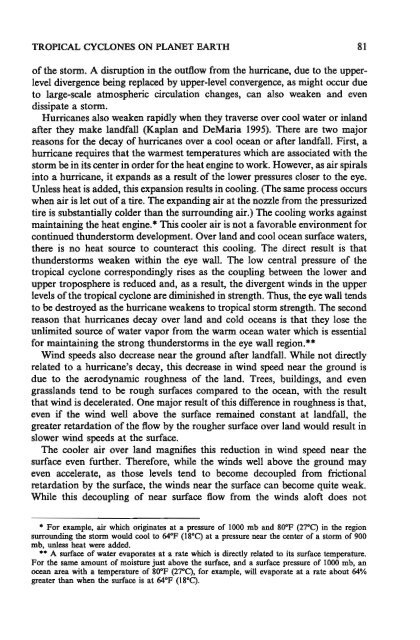Hurricanes: Their Nature and Impacts on Society - Climate Science ...
Hurricanes: Their Nature and Impacts on Society - Climate Science ...
Hurricanes: Their Nature and Impacts on Society - Climate Science ...
You also want an ePaper? Increase the reach of your titles
YUMPU automatically turns print PDFs into web optimized ePapers that Google loves.
TROPICAL CYCLONES ON PLANET EARTH<br />
of the storm. A disrupti<strong>on</strong> in the outflow from the hurricane, due to the upperlevel<br />
divergence being replaced by upper-level c<strong>on</strong>vergence, as might occur due<br />
to large-scale atmospheric circulati<strong>on</strong> changes, can also weaken <str<strong>on</strong>g>and</str<strong>on</strong>g> even<br />
dissipate a storm.<br />
<str<strong>on</strong>g>Hurricanes</str<strong>on</strong>g> also weaken rapidly when they traverse over cool water or inl<str<strong>on</strong>g>and</str<strong>on</strong>g><br />
after they make l<str<strong>on</strong>g>and</str<strong>on</strong>g>fall (Kaplan <str<strong>on</strong>g>and</str<strong>on</strong>g> DeMaria 1995). There are two major<br />
reas<strong>on</strong>s for the decay of hurricanes over a cool ocean or after l<str<strong>on</strong>g>and</str<strong>on</strong>g>fall. First, a<br />
hurricane requires that the warmest temperatures which are associated with the<br />
storm be in its center in order for the heat engine to work. However, as air spirals<br />
into a hurricane, it exp<str<strong>on</strong>g>and</str<strong>on</strong>g>s as a result of the lower pressures closer to the eye.<br />
Unless heat is added, this expansi<strong>on</strong> results in cooling. (The same process occurs<br />
when air is let out of a tire. The exp<str<strong>on</strong>g>and</str<strong>on</strong>g>ing air at the nozzle from the pressurized<br />
tire is substantially colder than the surrounding air.) The cooling works against<br />
maintaining the heat engine.. This cooler air is not a favorable envir<strong>on</strong>ment for<br />
c<strong>on</strong>tinued thunderstorm development. Over l<str<strong>on</strong>g>and</str<strong>on</strong>g> <str<strong>on</strong>g>and</str<strong>on</strong>g> cool ocean surface waters,<br />
there is no heat source to counteract this cooling. The direct result is that<br />
thunderstorms weaken within the eye wall. The low central pressure of the<br />
tropical cycl<strong>on</strong>e corresp<strong>on</strong>dingly rises as the coupling between the lower <str<strong>on</strong>g>and</str<strong>on</strong>g><br />
upper troposphere is reduced <str<strong>on</strong>g>and</str<strong>on</strong>g>, as a result, the divergent winds in the upper<br />
levels of the tropical cycl<strong>on</strong>e are diminished in strength. Thus, the eye wall tends<br />
to be destroyed as the hurricane weakens to tropical storm strength. The sec<strong>on</strong>d<br />
reas<strong>on</strong> that hurricanes decay over l<str<strong>on</strong>g>and</str<strong>on</strong>g> <str<strong>on</strong>g>and</str<strong>on</strong>g> cold oceans is that they lose the<br />
unlimited source of water vapor from the warm ocean water which is essential<br />
for maintaining the str<strong>on</strong>g thunderstorms in the eye wall regi<strong>on</strong>...<br />
Wind speeds also decrease near the ground after l<str<strong>on</strong>g>and</str<strong>on</strong>g>fall. While not directly<br />
related to a hurricane's decay, this decrease in wind speed near the ground is<br />
due to the aerodynamic roughness of the l<str<strong>on</strong>g>and</str<strong>on</strong>g>. Trees, buildings, <str<strong>on</strong>g>and</str<strong>on</strong>g> even<br />
grassl<str<strong>on</strong>g>and</str<strong>on</strong>g>s tend to be rough surfaces compared to the ocean, with the result<br />
that wind is decelerated. One major result of this difference in roughness is that,<br />
even if the wind well above the surface remained c<strong>on</strong>stant at l<str<strong>on</strong>g>and</str<strong>on</strong>g>fall, the<br />
greater retardati<strong>on</strong> of the flow by the rougher surface over l<str<strong>on</strong>g>and</str<strong>on</strong>g> would result in<br />
slower wind speeds at the surface.<br />
The cooler air over l<str<strong>on</strong>g>and</str<strong>on</strong>g> magnifies this reducti<strong>on</strong> in wind speed near the<br />
surface even further. Therefore, while the winds well above the ground may<br />
even accelerate, as those levels tend to become decoupled from fricti<strong>on</strong>al<br />
retardati<strong>on</strong> by the surface, the winds near the surface can become quite weak.<br />
While this decoupling of near surface flow from the winds aloft does not<br />
.For example, air which originates at a pressure of 1000 mb <str<strong>on</strong>g>and</str<strong>on</strong>g> 80°F (27°C) in the regi<strong>on</strong><br />
surrounding the storm would cool to 64°F (18°C) at a pressure near the center of a storm of 900<br />
mb, unless heat were added.<br />
..A surface of water evaporates at a rate which is directly related to its surface temperature.<br />
For the same amount of moisture just above the surface, <str<strong>on</strong>g>and</str<strong>on</strong>g> a surface pressure of 1000 mb, an<br />
ocean area with a temperature of 80°F (27°C), for example, will evaporate at a rate about 64%<br />
greater than when the surface is at 64°F (18°C).<br />
81














